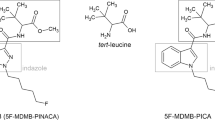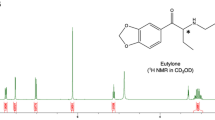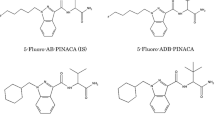Abstract
We report a case of intoxication by the synthetic cannabinoid MAM-2201 ([1-(5-fluoropentyl)-1H-indol-3-yl](4-methyl-1-naphthalenyl)-methanone). A 31-year-old man smoked about 300 mg of a herbal blend. He experienced an acute transient psychotic state with agitation, aggression, anxiety, and vomiting associated with a sympathomimetic syndrome. MAM-2201 was detected and quantified in a plasma sample using liquid chromatography-tandem mass spectrometry (LC–MS–MS). The level was 49 ng/ml 1 h after smoking. The use of other drugs was analytically excluded. The presence of MAM-2201 was confirmed in the herbal blend using gas chromatography–mass spectrometry (GC–MS) and LC–high resolution MS. This is the first description of an analytically confirmed intoxication and of the determination of MAM-2201 in human blood plasma.




Similar content being viewed by others
References
United Nations Office on Drugs and Crime (UNODC) (2011) World drug report 2011
Mechoulam R, Parker LA (2012) The endocannabinoid system and the brain. Annu Rev Psychol. doi:10.1146/annurev-psych-113011-143739
Fattore L, Fratta W (2011) Beyond THC: the new generation of cannabinoid designer drugs. Front Behav Neurosci 5:60
Vardakou I, Pistos C, Spiliopoulou C (2010) Spice drugs as a new trend: mode of action, identification and legislation. Toxicol Lett 197:157–162
Ginsburg BC, McMahon LR, Sanchez JJ, Javors MA (2012) Purity of synthetic cannabinoids sold online for recreational use. J Anal Toxicol 36:66–68
Auwärter V, Dresen S, Weinmann W, Müller M, Pütz M, Ferreirós N (2009) ‘Spice’ and other herbal blends: harmless incense or cannabinoid designer drugs? J Mass Spectrom 44:832–837
Uchiyama N, Kikura-Hanajiri R, Kawahara N, Haishima Y, Goda Y (2009) Identification of a cannabinoid analog as a new type of designer drug in a herbal product. Chem Pharm Bull (Tokyo) 57:439–441
Uchiyama N, Kikura-Hanajiri R, Kawahara N, Goda Y (2009) Identification of a cannabimimetic indole as a designer drug in a herbal product. Forensic Toxicol 27:61–66
Zuba D, Byrska B, Maciow M (2011) Comparison of “herbal highs” composition. Anal Bioanal Chem 400:119–126
Uchiyama N, Kikura-Hanajiri R, Goda Y (2011) Identification of a novel cannabimimetic phenylacetylindole, cannabipiperidiethanone, as a designer drug in a herbal product and its affinity for cannabinoid CB1 and CB2 receptors. Chem Pharm Bull (Tokyo) 59:1203–1205
Uchiyama N, Kawamura M, Kikura-Hanajiri R, Goda Y (2011) Identification and quantitation of two cannabimimetic phenylacetylindoles JWH-251 and JWH-250, and four cannabimimetic naphthoylindoles JWH-081, JWH-015, JWH-200, and JWH-073 as designer drugs in illegal products. Forensic Toxicol 29:25–37
Nakajima J, Takahashi M, Seto T, Suzuki J (2011) Identification and quantitation of cannabimimetic compound JWH-250 as an adulterant in products obtained via the Internet. Forensic Toxicol 29:51–55
Nakajima J, Takahashi M, Seto T, Kanai C, Suzuki J, Yoshida M, Hamano T (2011) Identification and quantitation of two benzoylindoles AM-694 and (4-methoxyphenyl)(1-pentyl-1H-indol-3-yl)methanone, and three cannabimimetic naphthoylindoles JWH-210, JWH-122, and JWH-019 as adulterants in illegal products obtained via the Internet. Forensic Toxicol 29:95–110
Nakajima J, Takahashi M, Nonaka R, Seto T, Suzuki J, Yoshida M, Kanai C, Hamano T (2011) Identification and quantitation of a benzoylindole (2-methoxyphenyl)(1-pentyl-1H-indol-3-yl)methanone and a naphthoylindole 1-(5-fluoropentyl-1H-indol-3-yl)-(naphthalene-1-yl)methanone (AM-2201) found in illegal products obtained via the Internet and their cannabinomimetic effects evaluated by in vitro [35S]GTPγS binding assays. Forensic Toxicol 29:132–141
Simolka K, Lindigkeit R, Schiebel HM, Papke U, Ernst L, Beuerle T (2012) Analysis of synthetic cannabinoids in “spice-like” herbal highs: snapshot of the German market in summer 2011. Anal Bioanal Chem 404:157–171
Nakajima J, Takahashi M, Seto T, Yoshida M, Kanai C, Suzuki J, Hamano T (2012) Identification and quantitation of two new naphthoylindole drugs-of-abuse (1-(5-hydroxypentyl)-1H-indol-3-yl)(naphthalen-1-yl)methanone (AM-2202) and (1-(4-pentyl)-1H-indol-3-yl)(naphthalen-1-yl)methanone, with other synthetic cannabinoids in unregulated “herbal” products circulated in the Tokyo area. Forensic Toxicol 30:33–44
Uchiyama N, Kawamura M, Kikura-Hanajiri R, Goda Y (2012) Identification of two new-type synthetic cannabinoids, N-(1-adamantyl)-1-pentyl-1H-indole-3-carboxamide (APICA) and N-(1-adamantyl)-1-pentyl-1H-indazole-3-carboxamide (APINACA), and detection of five synthetic cannabinoids, AM-1220, AM-2233, AM-1241, CB-13 (CRA-13), and AM-1248, as designer drugs in illegal products. Forensic Toxicol 30:114–125
Kneisel S, Bisel P, Brecht V, Broecker S, Müller M, Auwärter V (2012) Identification of the cannabimimetic AM-1220 and its azepane isomer (N-methylazepan-3-yl)-3-(1-naphthoyl)indole in a research chemical and several herbal mixtures. Forensic Toxicol 30:126–134
Vandrey R, Dunn KE, Fry JA, Girling ER (2012) A survey study to characterize use of Spice products (synthetic cannabinoids). Drug Alcohol Depend 120:238–241
Seely KA, Lapoint J, Moran JH, Fattore L (2012) Spice drugs are more than harmless herbal blends: a review of the pharmacology and toxicology of synthetic cannabinoids. Prog Neuropsychopharmacol Biol Psychiatry 39:234–243
Kikura-Hanajiri R, Uchiyama N, Goda Y (2011) Survey of current trends in the abuse of psychotropic substances and plants in Japan. Legal Med (Tokyo) 13:109–115
Moosmann B, Kneisel S, Girreser U, Brecht V, Westphal F, Auwärter V (2012) Separation and structural characterization of the synthetic cannabinoids JWH-412 and 1-[(5-fluoropentyl)-1H-indol-3yl]-(4-methylnaphthalen-1-yl)methanone using GC–MS, NMR analysis and a flash chromatography system. Forensic Sci Int 220:e17–e22
Maurer HH, Pfleger K, Weber AA (2011) Mass spectral and GC data of drugs, poisons, pesticides, pollutants and their metabolites, 4th edn. Wiley-VCH, Weinheim
Peters FT, Drummer OH, Musshoff F (2007) Validation of new methods. Forensic Sci Int 165:216–224
Matuszewski BK, Constanzer ML, Chavez-Eng CM (2003) Strategies for the assessment of matrix effect in quantitative bioanalytical methods based on HPLC–MS/MS. Anal Chem 75:3019–3030
Muller H, Huttner HB, Kohrmann M, Wielopolski JE, Kornhuber J, Sperling W (2010) Panic attack after spice abuse in a patient with ADHD. Pharmacopsychiatry 43:152–153
Muller H, Sperling W, Kohrmann M, Huttner HB, Kornhuber J, Maler JM (2010) The synthetic cannabinoid Spice as a trigger for an acute exacerbation of cannabis induced recurrent psychotic episodes. Schizophr Res 118:309–310
Schneir AB, Cullen J, Ly BT (2011) “Spice” girls: synthetic cannabinoid intoxication. J Emerg Med 40:296–299
Gunderson EW, Haughey HM, Ait-Daoud N, Joshi AS, Hart CL (2012) “Spice” and “K2″ herbal highs: a case series and systematic review of the clinical effects and biopsychosocial implications of synthetic cannabinoid use in humans. Am J Addict 21:320–326
Cohen J, Morrison S, Greenberg J, Saidinejad M (2012) Clinical presentation of intoxication due to synthetic cannabinoids. Pediatrics 129:e1064–e1067
Castellanos D, Thornton G (2012) Synthetic cannabinoid use: recognition and management. J Psychiatr Pract 18:86–93
Vandrey R, Umbricht A, Strain EC (2011) Increased blood pressure after abrupt cessation of daily cannabis use. J Addict Med 5:16–20
Ashton JC (2012) Synthetic cannabinoids as drugs of abuse. Curr Drug Abuse Rev 5:158–168
Gash A, Karliner JS, Janowsky D, Lake CR (1978) Effects of smoking marihuana on left ventricular performance and plasma norepinephrine: studies in normal men. Ann Intern Med 89:448–452
Weiss JL, Watanabe AM, Lemberger L, Tamarkin NR, Cardon PV (1972) Cardiovascular effects of delta-9-tetrahydrocannabinol in man. Clin Pharmacol Ther 13:671–684
Lapoint J, James LP, Moran CL, Nelson LS, Hoffman RS, Moran JH (2011) Severe toxicity following synthetic cannabinoid ingestion. Clin Toxicol 49:760–764
Mir A, Obafemi A, Young A, Kane C (2011) Myocardial infarction associated with use of the synthetic cannabinoid K2. Pediatrics 128:e1622–e1627
Korczyn AD, Eshel Y (1982) Mydriasis induced by tetrahydrocannabinol (THC) in rats. Invest Ophthalmol Vis Sci 22:408–410
Niederhoffer N, Schmid K, Szabo B (2003) The peripheral sympathetic nervous system is the major target of cannabinoids in eliciting cardiovascular depression. Naunyn Schmiedebergs Arch Pharmacol 367:434–443
Derungs A, Schietzel S, Meyer MR, Maurer HH, Krahenbuhl S, Liechti ME (2011) Sympathomimetic toxicity in a case of analytically confirmed recreational use of naphyrone (naphthylpyrovalerone). Clin Toxicol 49:691–693
Hudson S, Ramsey J (2011) The emergence and analysis of synthetic cannabinoids. Drug Test Anal 3:466–478
Author information
Authors and Affiliations
Corresponding author
Additional information
A. Derungs and A. E. Schwaninger contributed equally to this work.
Rights and permissions
About this article
Cite this article
Derungs, A., Schwaninger, A.E., Mansella, G. et al. Symptoms, toxicities, and analytical results for a patient after smoking herbs containing the novel synthetic cannabinoid MAM-2201. Forensic Toxicol 31, 164–171 (2013). https://doi.org/10.1007/s11419-012-0166-1
Received:
Accepted:
Published:
Issue Date:
DOI: https://doi.org/10.1007/s11419-012-0166-1




